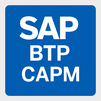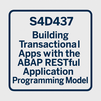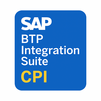.jpg)
The SAP Reinsurance Management (FS-RI) course provides comprehensive training on automating and managing reinsurance activities within SAP. Participants will learn to configure treaties, process cessions, manage claims recoveries, and perform technical accounting for both ceded and assumed reinsurance. The course also covers integration with SAP Financials and FS-CD for accurate financial tracking. Designed for insurance professionals and SAP consultants, this course enhances the ability to handle complex reinsurance arrangements efficiently and in compliance with regulatory standards.
SAP Reinsurance Management (FS-RI) Training Interview Questions Answers - For Intermediate
1. What are the key components of a reinsurance treaty in FS-RI?
A reinsurance treaty in FS-RI is composed of several key components including the treaty type (proportional or non-proportional), the participating business partners, the cession rules, premium and commission terms, and coverage period. It also contains layer information for non-proportional treaties and details about loss participation or profit sharing if applicable. Each component is critical in defining how the reinsurance business will be managed, calculated, and accounted for within the system.
2. How does FS-RI handle multi-year treaties?
FS-RI is designed to accommodate multi-year treaties by allowing configuration of contract validity periods and renewal logic. The system supports tracking of financials and claims across multiple fiscal years under the same treaty umbrella. Each renewal or amendment can be versioned for auditability, and premiums and claims are linked to the correct accounting period and treaty version for compliance and accuracy.
3. What is the use of ‘facultative reinsurance’ in FS-RI?
Facultative reinsurance is used in FS-RI for reinsurance agreements covering individual risks that do not fall under treaty agreements. It is manually underwritten and negotiated per case. FS-RI supports facultative business by allowing creation of one-off contracts and ensuring they are linked to the appropriate risks or policies. This flexibility is especially useful for large or unusual risks that require individual attention.
4. Can FS-RI manage both inward and outward reinsurance in the same system?
Yes, FS-RI is capable of managing both inward (assumed) and outward (ceded) reinsurance in the same environment. For assumed reinsurance, the insurer acts as a reinsurer and processes incoming risk, premium, and claims data. For outward reinsurance, the system supports ceding part of the risk to other reinsurers. FS-RI maintains clear segregation and controls over these transactions through treaty configuration and posting logic.
5. What is the importance of ‘cession rules’ in FS-RI?
Cession rules in FS-RI define how much of the original policy risk or premium should be transferred to the reinsurer. These rules are essential for automating the calculation of reinsurance shares, ensuring consistent application across policies and claims. Cession can be based on percentage, amount limits, or layered structures depending on treaty type. Accurate configuration of these rules is critical for compliant financial reporting.
6. How are premiums and commissions posted in FS-RI?
Premiums and commissions in FS-RI are posted automatically based on treaty terms, policy transactions, and cession rules. When a premium is recorded in the underlying policy module, FS-RI calculates the ceded portion and the reinsurer’s commission. It then generates technical and financial postings to relevant accounts, ensuring that all financial records reflect the true reinsurance obligations and entitlements.
7. What role does FS-CD play in the FS-RI process?
FS-CD (SAP Collections and Disbursements) is tightly integrated with FS-RI for managing the financial transactions related to reinsurance such as incoming/outgoing payments, clearing, and dunning. FS-RI generates posting documents that are passed to FS-CD, where they are processed for payment and reconciliation. This integration enables real-time cash management, open item control, and efficient receivables and payables processing.
8. How does FS-RI ensure regulatory compliance?
FS-RI ensures compliance by offering features like audit trails, treaty versioning, integration with general ledger accounting, and support for IFRS and local GAAP. The module provides detailed documentation for every financial transaction and allows for easy reporting and audit checks. This enables insurers and reinsurers to comply with internal policies, regulatory frameworks, and external audit requirements.
9. What is a layer in non-proportional reinsurance, and how is it configured in FS-RI?
A layer in non-proportional reinsurance defines a specific range of loss coverage under a treaty. For example, a reinsurer may cover losses between $1 million and $5 million. FS-RI allows configuration of such layers within a treaty, enabling the system to allocate claims accurately across different reinsurers based on the covered layer, retention limits, and aggregate deductibles or limits.
10. How is reinsurance accounting performed in FS-RI?
Reinsurance accounting in FS-RI is performed through technical accounts, which collect premium, claim, and commission information. These are then transferred to the general ledger via integration with SAP FI. The system supports periodic closing, reconciliation reports, and creation of sub-ledgers, ensuring that the financials of reinsurance business are always accurate and auditable.
11. What types of reports can be generated in FS-RI?
FS-RI provides standard reporting tools to generate reports on premium flows, claims settlements, outstanding balances, commission settlements, and treaty performance. These reports are used by actuarial, finance, and operations teams. Custom reports can also be built using SAP BW or SAP Analytics Cloud, offering deep insights into reinsurance business trends and enabling data-driven decisions.
12. What are the typical challenges in implementing FS-RI?
Common challenges include complex treaty configurations, integration with other SAP and non-SAP systems, data migration from legacy systems, and ensuring consistency in cession rules. Additionally, aligning FS-RI processes with the insurer’s existing finance and claims processes requires detailed planning and expertise. Change management and training are also essential to ensure smooth adoption by users.
13. How are reinstatement premiums handled in FS-RI?
Reinstatement premiums occur when the limit under a non-proportional treaty is exhausted, and the treaty allows for reinstatement of coverage for an additional premium. FS-RI can calculate such premiums based on claims paid and treaty terms. The system automatically generates the required accounting entries and integrates the reinstatement premium into the overall technical account of the treaty.
14. How does FS-RI support audit and reconciliation?
FS-RI supports audits through comprehensive version control, detailed transactional logs, and integration with SAP’s financial audit tools. It tracks every change to treaty configurations, cession rules, and postings. Reconciliation reports can be generated to verify postings against ledger balances, and variance analyses can be conducted across treaties, periods, or business partners.
15. Can FS-RI be used for both primary insurers and reinsurers?
Yes, FS-RI is versatile and can be used by both primary insurers that cede business and by reinsurers that assume risk. The system has capabilities to handle both ends of the reinsurance transaction lifecycle. Its robust architecture allows companies to use the same platform for managing outward and inward reinsurance, simplifying operations and reducing IT overhead.
SAP Reinsurance Management (FS-RI) Training Interview Questions Answers - For Advanced
1. What considerations must be made when designing reinsurance programs using both proportional and non-proportional treaties in FS-RI?
Designing reinsurance programs that combine proportional and non-proportional treaties in FS-RI requires a nuanced understanding of cession rules, risk exposure, and treaty layering. Proportional treaties like quota share and surplus cede a fixed portion of risk and premium, whereas non-proportional treaties like excess of loss apply only after a certain retention threshold is met. In FS-RI, these are configured through distinct treaty types with individual cession logic and financial terms. The challenge lies in sequencing them appropriately—premiums and claims must first flow through the proportional layer and then through the non-proportional protection. Accurate layering ensures correct reinsurance recoverables, reinstatement premiums, and profit commission calculations. Additional complexity arises when surplus treaties have varying lines or when non-proportional treaties have multi-tiered structures. FS-RI allows such configurations through detailed layering structures, versioning, and conditional cession logic, but careful testing and business alignment are critical to avoid erroneous settlements or understated liabilities.
2. How does FS-RI handle overlapping treaties or multiple reinsurance covers for a single risk?
FS-RI can handle overlapping treaties and multiple layers of coverage by prioritizing treaties using defined cession strategies. These strategies include sequence-based allocation, percentage share split, and retention logic. For instance, if a single risk is covered under both a facultative and treaty arrangement, FS-RI allows the user to define which contract takes precedence and to what extent. In overlapping treaties, the system uses configuration rules to avoid over-cession or duplicate recoverable bookings. Each treaty can be assigned to different portfolio segments, claim classes, or policy groups, and FS-RI evaluates eligibility based on these attributes during transaction processing. A robust treaty layering and priority matrix ensures accurate distribution of premiums and claims, while avoiding financial discrepancies across technical accounts.
3. Describe the process of customizing cession rules in FS-RI to handle dynamic business scenarios.
Cession rules in FS-RI determine how much premium and risk is ceded to reinsurers. Customizing these rules to accommodate dynamic business scenarios—like volume-dependent cession percentages, territory-based allocations, or product-specific logic—requires advanced IMG configuration. FS-RI allows users to define cession formulas using variables such as sum insured, line of business, underwriting year, or claim loss amount. Condition techniques similar to SD pricing can be used to set thresholds and exception rules. For highly dynamic requirements, user exits or BAdIs (Business Add-Ins) can be implemented to calculate cession values at runtime. FS-RI also supports multiple versions of cession rules to reflect changes over time without retroactive impacts. When properly configured, these rules automate the cession process even in highly segmented or volatile business environments, ensuring both flexibility and control.
4. What are the best practices for implementing version control for treaties in FS-RI?
Version control in FS-RI ensures that treaty changes over time—such as participant changes, cession percentage updates, or premium terms—are documented without losing historical consistency. Best practices include creating a new version for every contractual change and assigning effective dates accurately so that existing transactions are not retroactively impacted. Each version should be fully documented with references to contract addendums and audit notes. Users should restrict version creation to authorized roles and implement workflow-based approval for changes. During financial period-end closings, treaty versions should be locked to avoid inconsistent revaluation. FS-RI automatically applies the correct version based on transaction date, but reconciliation reports should be regularly reviewed to ensure no misaligned data exists between treaty versions and financial transactions.
5. How does FS-RI support multi-currency treaties and what challenges are typically encountered?
FS-RI supports multi-currency treaties by enabling separate contract currencies and transaction currencies at the treaty and technical account levels. Currency conversion is handled using SAP’s standard exchange rate tables, which are integrated with FI and CO modules. The challenge in multi-currency scenarios lies in exchange rate fluctuations between booking and settlement dates. FS-RI addresses this by recording both original and local currency values and maintaining realized/unrealized FX differences. Additionally, financial postings can be configured to recognize currency gains and losses and assign them to appropriate GL accounts. Care must be taken to synchronize exchange rate tables across modules to avoid mismatches, especially when generating bordereaux or performing financial reconciliation across currencies.
6. How can SAP FS-RI be enhanced using SAP BTP or custom development?
SAP FS-RI can be enhanced using the SAP Business Technology Platform (BTP) to introduce cloud-native capabilities, automate workflows, or integrate with external reinsurer portals. For example, custom apps can be developed on BTP using SAP Fiori/UI5 to provide treaty dashboards, claim triage tools, or bordereaux approval workflows. SAP Integration Suite on BTP can be used to connect FS-RI with external reinsurer systems using REST APIs or EDI for real-time settlement status updates. Advanced analytics and forecasting can be integrated using SAP AI Core or HANA ML services, allowing predictive loss ratio analysis or automatic treaty renewal recommendations. Custom ABAP enhancements in the ECC or S/4HANA system can also be deployed, including user exits in cession logic or enhancements in technical account postings.
7. What are the key elements of auditing a reinsurance program in FS-RI?
Auditing a reinsurance program in FS-RI involves reviewing treaty data integrity, transaction accuracy, compliance with cession rules, and reconciliation with financial records. Key elements include version audit trails for treaties, logs of premium and claims cession, and validation of accounting entries against ledger balances. FS-RI provides audit-relevant reports such as claim recovery logs, technical account ledgers, and bordereaux comparison files. Auditors often review the linkage between assumed and ceded business, especially in retrocession scenarios. The system also supports logging of user actions, changes to master data, and access rights, which are critical for regulatory audits. Periodic reconciliation with SAP FI and external statements from reinsurers ensures end-to-end transparency.
8. How does FS-RI handle Reinsurance Commutation?
Reinsurance commutation refers to the process of terminating a reinsurance contract and settling all outstanding liabilities and receivables between the cedent and reinsurer. In FS-RI, commutation is handled by first generating a final valuation of all open premiums, claims, reserves, commissions, and profit-sharing amounts. These are then processed as a final lump-sum settlement entry in the technical account. The system allows documentation of commutation terms, assignment of agreement references, and closure of the relevant treaty version or entire contract. FS-RI also supports posting of write-offs or adjustments resulting from negotiated settlements. Commutation postings are integrated with FS-CD and SAP FI for payment and reconciliation, ensuring all future cash flows related to the treaty are closed.
9. How can SAP FS-RI support actuarial teams with risk modeling and forecasting?
FS-RI provides actuarial teams with structured and granular data on premiums, claims, recoveries, and reserves—segmented by treaty, line of business, geography, and underwriting year. This data can be extracted into SAP BW/4HANA or external data warehouses for modeling and forecasting. FS-RI also supports incurred and reported claim triangles, which are essential for loss development factor (LDF) analysis. Actuarial teams can assess the effectiveness of different reinsurance strategies by simulating loss scenarios and comparing recoveries under different treaty configurations. Integration with SAP Analytics Cloud allows predictive modeling, trend analysis, and dashboard reporting to evaluate reinsurance performance and risk mitigation efficiency.
10. What challenges arise when reconciling reinsurance balances between FS-RI and general ledger?
Reconciliation challenges typically arise from timing differences, incorrect mapping of technical accounts to GL accounts, or manual adjustments made outside of FS-RI. Inaccurate or delayed treaty versioning can also cause transactions to post to the wrong ledger period. FS-RI supports reconciliation through drill-down reports that show the link between transaction data and corresponding GL entries. Best practices include locking GL periods post-reconciliation, regular variance analysis between FS-RI and FI, and ensuring that all reinsurance adjustments are posted through standardized processes. Period-end reconciliation should also include FX revaluation, aging of open items, and alignment of settlement data with FS-CD.
11. How does FS-RI handle the calculation and posting of reinstatement premiums in excess of loss treaties?
Reinstatement premiums are additional premiums charged when a loss exhausts part or all of the coverage limit in a non-proportional treaty. FS-RI automatically tracks the usage of the coverage layer and triggers reinstatement logic based on defined treaty rules. The reinstatement premium is calculated proportionally or on a flat rate basis and can be posted immediately or deferred. FS-RI creates the reinstatement premium entries in the technical account and integrates with FS-CD for billing and settlement. The system supports single and multiple reinstatements and can also account for minimum premium thresholds. Proper configuration ensures that claims and reinstatement premiums are accurately reflected in both the technical account and financial ledgers.
12. What is the impact of incorrect treaty setup in FS-RI and how can it be mitigated?
Incorrect treaty setup—such as wrong cession percentage, misaligned effective dates, or incorrect reinsurer shares—can lead to cascading errors in premium cessions, claims recoverables, profit commission calculations, and financial postings. These errors can affect both internal reporting and external settlements. To mitigate this, FS-RI supports validation rules, simulation modes for treaties, and change logs. Regular testing of new treaties in QA environments, cross-functional reviews during treaty setup, and periodic reconciliation checks help ensure treaty integrity. System-level controls, such as approval workflows and versioning, can further minimize human error and ensure consistent and auditable configurations.
13. How does FS-RI support facultative reinsurance and what are its limitations?
Facultative reinsurance in FS-RI is used to reinsure specific risks not covered under existing treaties. FS-RI allows manual creation of facultative contracts linked to specific policies, with configurable terms for cession, commission, and claims settlement. Each facultative contract can be individually tracked and processed in the technical account. However, limitations include the lack of automated mass processing (as facultative covers are typically few and custom), and additional manual steps required for claims linkage and bordereaux generation. Still, FS-RI provides a structured way to manage facultative reinsurance, ensuring these exceptions are properly accounted and reported.
14. What reporting tools are available in FS-RI for performance monitoring and analytics?
FS-RI offers standard SAP ALV reports for technical account balances, treaty performance, claim recoverables, and bordereaux. These reports can be filtered by treaty, period, business partner, or product line. For advanced analytics, integration with SAP BW/4HANA and SAP Analytics Cloud allows creation of dashboards and KPIs such as ceded ratio, loss ratio after reinsurance, and reinsurer credit risk exposure. FS-RI also supports extractors to feed actuarial models, risk-based capital assessments, and regulatory disclosures. Period-end reports can be automated and scheduled, and exception reports can highlight data mismatches or treaty violations.
15. How does FS-RI facilitate collaboration between underwriting, claims, and finance teams?
FS-RI serves as a central system that connects underwriting (treaty setup), claims (reinsurance recoveries), and finance (technical accounting). Shared master data such as business partners, treaties, and technical accounts ensures consistency. FS-RI’s transaction flow—starting from policy/claim processing to cession and financial posting—provides transparency for all stakeholders. Underwriters can access performance data to refine reinsurance strategies, while claims teams can track expected recoverables and trigger recovery notifications. Finance teams benefit from real-time accounting entries and reconciliation tools. Workflow integration, version control, and reporting capabilities enable these departments to work in a cohesive and audit-compliant manner.
Course Schedule
| Dec, 2025 | Weekdays | Mon-Fri | Enquire Now |
| Weekend | Sat-Sun | Enquire Now | |
| Jan, 2026 | Weekdays | Mon-Fri | Enquire Now |
| Weekend | Sat-Sun | Enquire Now |
Related Courses
Related Articles
Related Interview
Related FAQ's
- Instructor-led Live Online Interactive Training
- Project Based Customized Learning
- Fast Track Training Program
- Self-paced learning
- In one-on-one training, you have the flexibility to choose the days, timings, and duration according to your preferences.
- We create a personalized training calendar based on your chosen schedule.
- Complete Live Online Interactive Training of the Course
- After Training Recorded Videos
- Session-wise Learning Material and notes for lifetime
- Practical & Assignments exercises
- Global Course Completion Certificate
- 24x7 after Training Support











 Join our Live Instructor-Led online classes delivered by industry experts
Join our Live Instructor-Led online classes delivered by industry experts